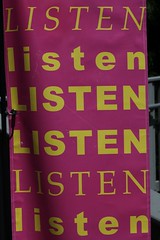 In Phyllis Korkki’s article entitled Subtle Cues Can Tell an Interviewer ‘Pick Me (New York Times “The Search” column,  September 12, 2009), I found several points well worth emphasizing for the nonprofit job seeker.  But, no lesson could be more important than to do your due diligence before a job interview.  Be prepared to speak intelligibly about your understanding of the organization, its mission and challenges.   And by all means, understand what not to say.
In Phyllis Korkki’s article entitled Subtle Cues Can Tell an Interviewer ‘Pick Me (New York Times “The Search” column,  September 12, 2009), I found several points well worth emphasizing for the nonprofit job seeker.  But, no lesson could be more important than to do your due diligence before a job interview.  Be prepared to speak intelligibly about your understanding of the organization, its mission and challenges.   And by all means, understand what not to say.
Below is my commentary on some key points in this article:
1) “…your success may depend on the company’s culture and the preferences of the people doing the hiring…”
The importance of  the company’s culture cannot be underestimated, especially in the nonprofit sector.  I work with nonprofits of all shapes and sizes and consequently with all sorts of “cultures”.  For example, some organization’s culture is “corporate”,  others are “family-oriented”, some are “consensus driven”,  others are “founder led.”  Understand the importance of the organization’s culture and its impact on your chances of success (and satisfaction) within the organization.  Demonstrate a sense of self-awareness of how you’d perform in such a culture.  For example, if the organization is founder-led or  family-oriented, you may wish to make appropriate references to successes you’ve had in such an environment.  Or, you may determine (before or after the interview) that a particular organizational culture is not a good fit for your style.  It may feel like a leap to make such a determination, but cultures are hard to change so the fit really is important.
2) “Try to establish common ground with your interviewer so you stand out … leverage your referrals”
Most of us understand that “who” you know is at times as important as “what” you know.  I emphasize “at times”  because you really want to be careful here in developing “common ground”.  Allow the interviewer to lead you to the areas where you may have things in common. For example, if the interviewer mentions an interest they have in a particular sport or team or brand (etc), and you sincerely share that interest, allow a conversation to flow from there.  With regard to referrals, if indeed you share some relevant or significant friendships, then hopefully the mutual friend has already talked to the interviewer about you.  Be careful not to appear as a “name dropper” and be even more careful to make sure there are good relationships between the interviewer and the person whose name you drop.   For example, if you know someone who works at the organization, make sure that person is a valued employee.  Do your due diligence!
3) “Make sure your questions show knowledge of the company and your interest in contributing to its success” and research the organization at which you will be interviewing.
Especially in the nonprofit sector, there is no excuse for not knowing the basics about an organization. Â Nonprofit organizations are required to disclose basic general information (agency mission, staffing, board or directors) as well as financial information (copies of their 990 tax returns). Â This information is available free of charge at Guidestar and also at Charity Navigator. Â As well, many nonprofits have extensive websites. Â Â Again, do your due diligence!
4) “It seems that just being yourself — albeit a formal, polite, alert and attentive version of yourself — is the best way to behave during interviews.”
Great advice!  If I sense the person I am interviewing is just being themselves (not “faking it”  or “trying too hard”), most often I will move that candidate to the next step in the process.   When I sense a person is comfortable with themselves, I feel an unspoken confidence.  For example, sometimes a candidate will honestly tell me they don’t know an answer to a question.  This way of  being …  a way of being oneself … is more impressive than a candidate who tries what we call the “dump truck” approach and responds to a question with three or more answers in hope that one of them will be “right”.  But, guess what?  That’s just the wrong way to impress an interviewer.
![]() photo credit:Â bionicteaching
photo credit:Â bionicteaching